2015 NISSAN GT-R child seat
[x] Cancel search: child seatPage 79 of 358
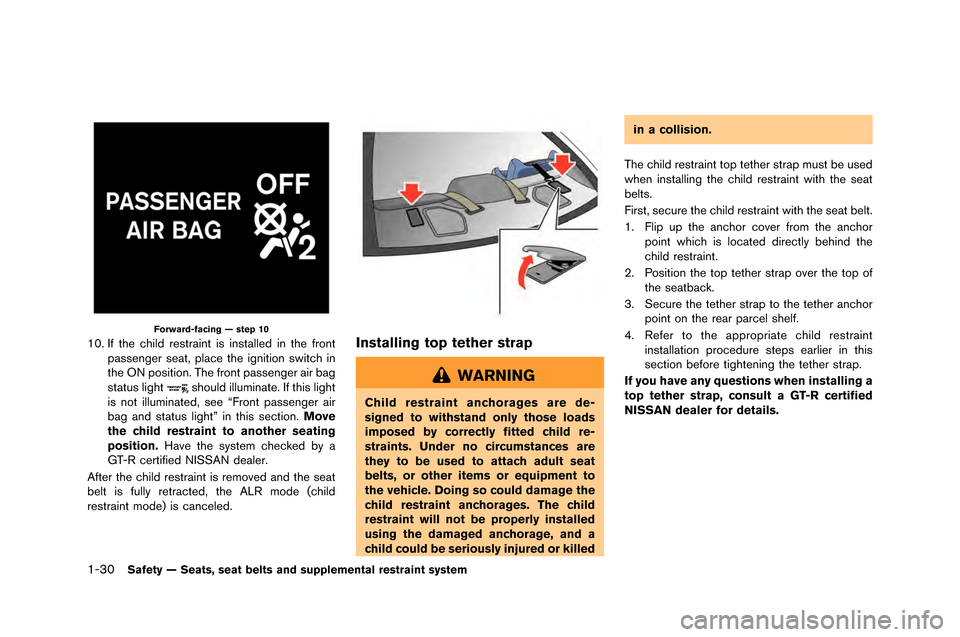
1-30Safety — Seats, seat belts and supplemental restraint system
Forward-facing — step 10
10. If the child restraint is installed in the front�fassenger seat, �flace the ignition switch in
the �bN �fosition. The front �fassenger air bag
status light
should illuminate. If this light
is not illuminated, see “Front �fassenger air
bag and status light” in this section. Move
the child restraint to another seating
position. Have the system checked by a
GT-R certified NISSAN dealer.
After the child restraint is removed and the seat
belt is fully retracted, the ALR mode (child
restraint mode) is canceled.
Installing top tether strap
WARNING
Child restraint anchorages are de-
signed to withstand only those loads
imposed by correctly fitted child re-
straints. Under no circumstances are
they to be used to attach adult seat
belts, or other items or equipment to
the vehicle. Doing so could damage the
child restraint anchorages. The child
restraint will not be properly installed
using the damaged anchorage, and a
child could be seriously injured or killed in a collision.
The child restraint to�f tether stra�f must be used
when installing the child restraint with the seat
belts.
First, secure the child restraint with the seat belt.
1. Fli�f u�f the anchor cover from the anchor �foint which is located directly behind the
child restraint.
2. Position the to�f tether stra�f over the to�f of the seatback.
3. Secure the tether stra�f to the tether anchor �foint on the rear �farcel shelf.
4. Refer to the a�f�fro�friate child restraint installation �frocedure ste�fs earlier in this
section before tightening the tether stra�f.
If you have any questions when installing a
top tether strap, consult a GT-R certified
NISSAN dealer for details.
Page 80 of 358
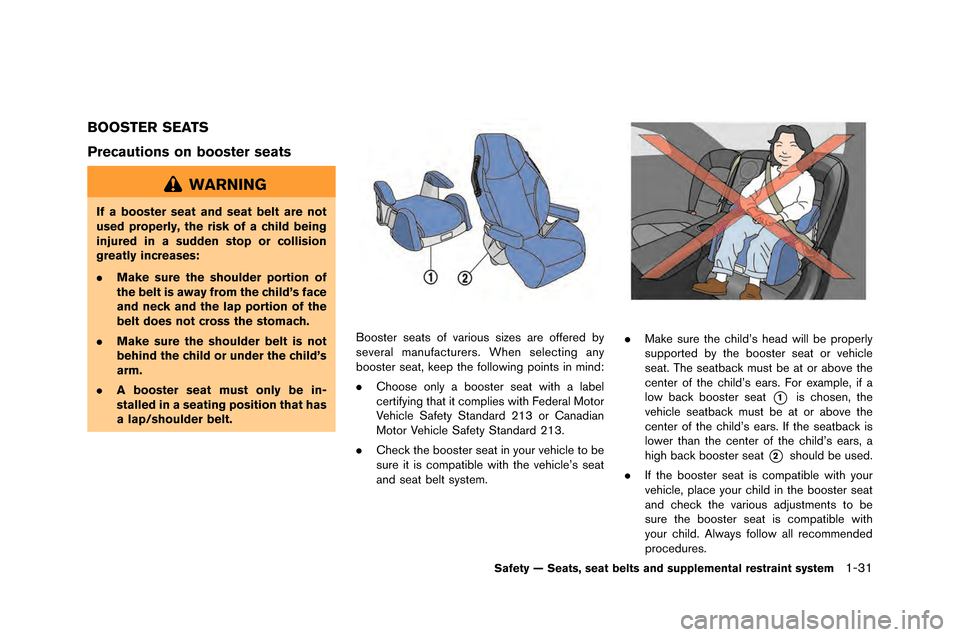
BOOSTER SEATS
Precautions on booster seats
WARNING
If a booster seat and seat belt are not
used properly, the risk of a child being
injured in a sudden stop or collision
greatly increases:
.Make sure the shoulder portion of
the belt is away from the child’s face
and neck and the lap portion of the
belt does not cross the stomach.
. Make sure the shoulder belt is not
behind the child or under the child’s
arm.
. A booster seat must only be in-
stalled in a seating position that has
a lap/shoulder belt.
Booster seats of various sizes are offered by
several manufacturers�f When selecting any
booster seat�b keep the following points in mind:
.Choose only a booster seat with a label
certifying that it complies with Federal Motor
Vehicle Safety Standard 213 or Canadian
Motor Vehicle Safety Standard 213�f
. Check the booster seat in your vehicle to be
sure it is compatible with the vehicle’s seat
and seat belt system�f.Make sure the child’s head will be properly
supported by the booster seat or vehicle
seat�f The seatback must be at or above the
center of the child’s ears�f For example�b if a
low back booster seat
*1is chosen�b the
vehicle seatback must be at or above the
center of the child’s ears�f If the seatback is
lower than the center of the child’s ears�b a
high back booster seat
*2should be used�f
. If the booster seat is compatible with your
vehicle�b place your child in the booster seat
and check the various adjustments to be
sure the booster seat is compatible with
your child�f Always follow all recommended
procedures�f
Safety — Seats, seat belts and supplemental restraint system1-31
Page 81 of 358
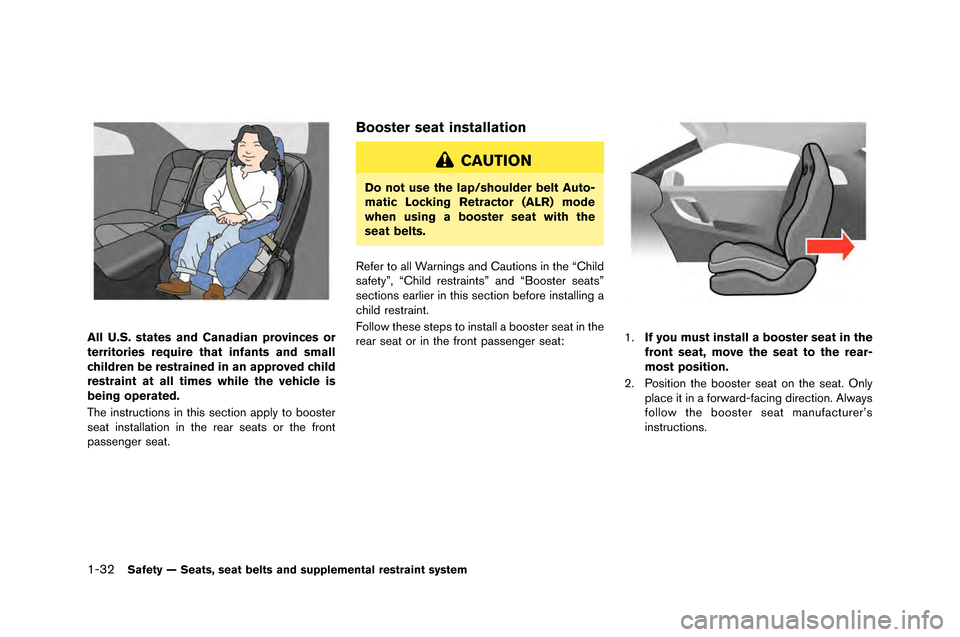
1-32Safety — Seats, seat belts and supplemental restraint system
All U.S. states and Canadian provinces or
territories require that infants and small
children be restrained in an approved child
restraint at all times while the vehicle is
being operated.
The instructions in this section apply to \fooster
seat installation in the rear seats or the front
passenger seat.
Booster seat installation
CAUTION
Do not use the lap/shoulder belt Auto-
matic Locking Retractor (ALR) mode
when using a booster seat with the
seat belts.
\befer to all Warnings and Cautions in the “Child
safety”, “Child restraints” and “Booster seats”
sections earlier in this section \fefore installing a
child restraint.
Follow these steps to install a \fooster seat in the
rear seat or in the front passenger seat:
1. If you must install a booster seat in the
front seat, move the seat to the rear-
most position.
2. Position the \fooster seat on the seat. Only place it in a forward-facing direction. Always
follow the \fooster seat manufacturer’s
instructions.
Page 82 of 358
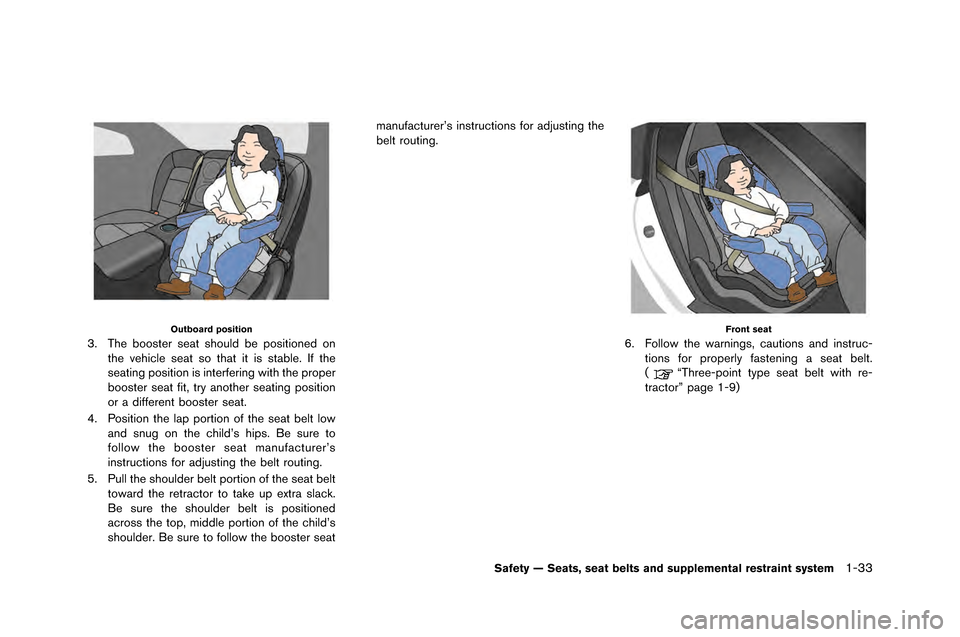
Outboard position
3. The booster seat should be positioned onthe vehicle seat so that it is stable. �ff the
seating position is interfering with the proper
booster seat fit�b try another seating position
or a different booster seat.
4. Position the lap portion of the seat belt low and snug on the child’s hips. Be sure to
follow the booster seat manufacturer’s
instructions for adjusting the belt routing.
5. Pull the shoulder belt portion of the seat belt toward the retractor to take up extra slack.
Be sure the shoulder belt is positioned
across the top�b middle portion of the child’s
shoulder. Be sure to follow the booster seat manufacturer’s instructions for adjusting the
belt routing.
Front seat
6. Follow the warnings�b cautions and instruc-
tions for properly fastening a seat belt.
(
“Three-point type seat belt with re-
tractor” page 1-9)
Safety — Seats, seat belts and supplemental restraint system1-33
Page 86 of 358
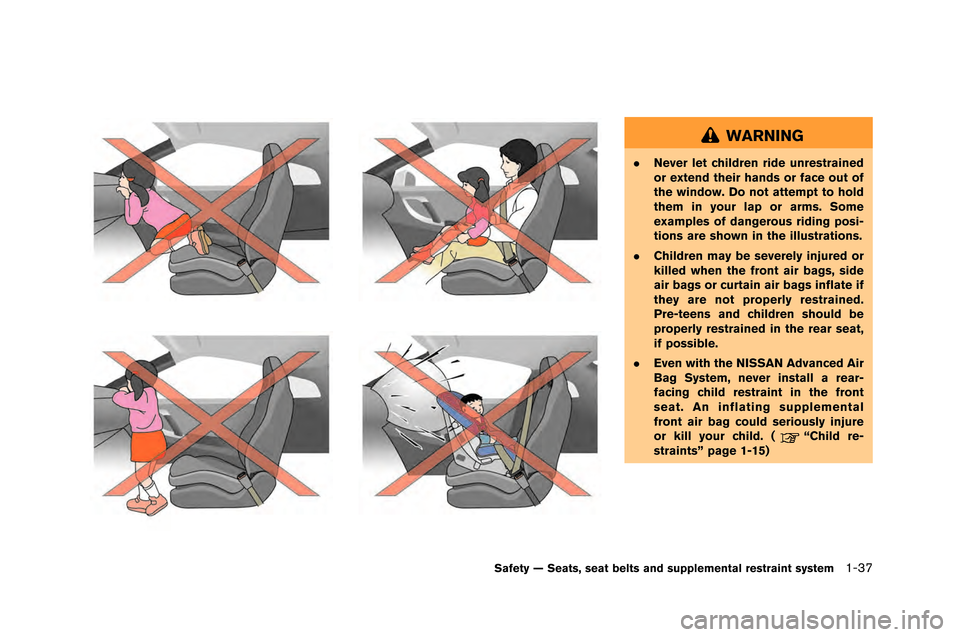
WARNING
.Never let children ride unrestrained
or extend their hands or face out of
the window. Do not attempt to hold
them in your lap or arms. Some
examples of dangerous riding posi-
tions are shown in the illustrations.
. Children may be severely injured or
killed when the front air bags, side
air bags or curtain air bags inflate if
they are not properly restrained.
Pre-teens and children should be
properly restrained in the rear seat,
if possible.
. Even with the NISSAN Advanced Air
Bag System, never install a rear-
facing child restraint in the front
seat. An inflating supplemental
front air bag could seriously injure
or kill your child. (
“Child re-
straints” page 1-15)
Safety — Seats, seat belts and supplemental restraint system1-37
Page 88 of 358
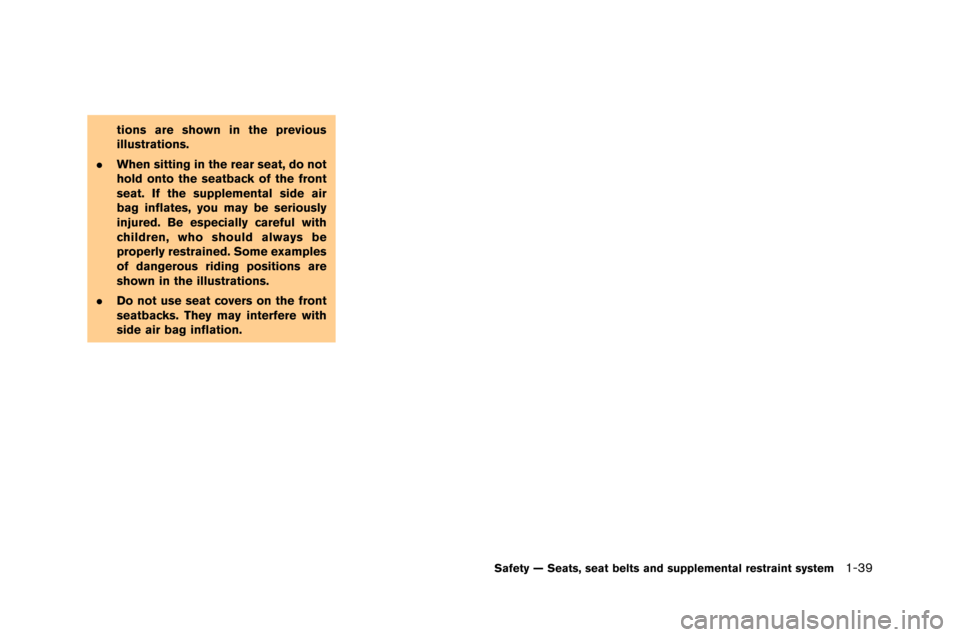
tions are shown in the previous
illustrations.
. When sitting in the rear seat, do not
hold onto the seatback of the front
seat. If the supplemental side air
bag inflates, you may be seriously
injured. Be especially careful with
children, who should always be
properly restrained. Some examples
of dangerous riding positions are
shown in the illustrations.
. Do not use seat covers on the front
seatbacks. They may interfere with
side air bag inflation.
Safety — Seats, seat belts and supplemental restraint system1-39
Page 90 of 358
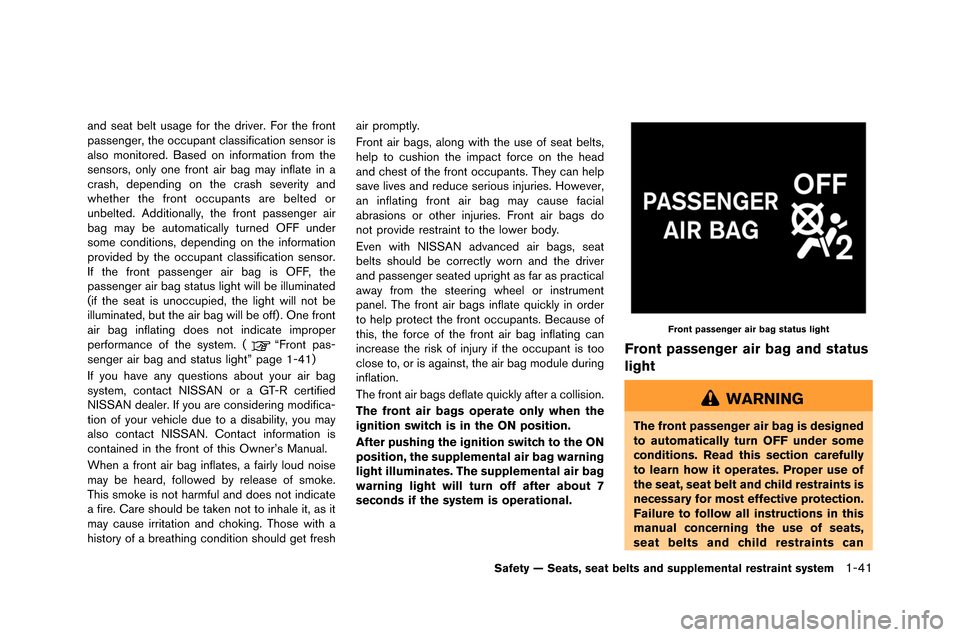
and seat belt usage for the driver. For the front
passenger�f the occupant classification sensor is
also monitored. Based on information from the
sensors�f onl�b one front air bag ma�b inflate in a
crash�f depending on the crash severit�b and
whether the front occupants are belted or
unbelted. Additionall�b�f the front passenger air
bag ma�b be automaticall�b turned OFF under
some conditions�f depending on the information
provided b�b the occupant classification sensor.
If the front passenger air bag is OFF�f the
passenger air bag status light will be illuminated
(if the seat is unoccupied�f the light will not be
illuminated�f but the air bag will be off) . One front
air bag inflating does not indicate improper
performance of the s�bstem. (
“Front pas-
senger air bag and status light” page 1-41)
If �bou have an�b questions about �bour air bag
s�bstem�f contact NISSAN or a GT-R certified
NISSAN dealer. If �bou are considering modifica-
tion of �bour vehicle due to a disabilit�b�f �bou ma�b
also contact NISSAN. Contact information is
contained in the front of this Owner’s Manual.
When a front air bag inflates�f a fairl�b loud noise
ma�b be heard�f followed b�b release of smoke.
This smoke is not harmful and does not indicate
a fire. Care should be taken not to inhale it�f as it
ma�b cause irritation and choking. Those with a
histor�b of a breathing condition should get fresh air promptl�b.
Front air bags�f along with the use of seat belts�f
help to cushion the impact force on the head
and chest of the front occupants. The�b can help
save lives and reduce serious injuries. However�f
an inflating front air bag ma�b cause facial
abrasions or other injuries. Front air bags do
not provide restraint to the lower bod�b.
Even with NISSAN advanced air bags�f seat
belts should be correctl�b worn and the driver
and passenger seated upright as far as practical
awa�b from the steering wheel or instrument
panel. The front air bags inflate quickl�b in order
to help protect the front occupants. Because of
this�f the force of the front air bag inflating can
increase the risk of injur�b if the occupant is too
close to�f or is against�f the air bag module during
inflation.
The front air bags deflate quickl�b after a collision.
The front air bags operate only when the
ignition switch is in the ON position.
After pushing the ignition switch to the ON
position, the supplemental air bag warning
light illuminates. The supplemental air bag
warning light will turn off after about 7
seconds if the system is operational.
Front passenger air bag status light
Front passenger air bag and status
light
WARNING
The front passenger air bag is designed
to automatically turn OFF under some
conditions. Read this section carefully
to learn how it operates. Proper use of
the seat, seat belt and child restraints is
necessary for most effective protection.
Failure to follow all instructions in this
manual concerning the use of seats,
seat belts and child restraints can
Safety — Seats, seat belts and supplemental restraint system1-41
Page 92 of 358
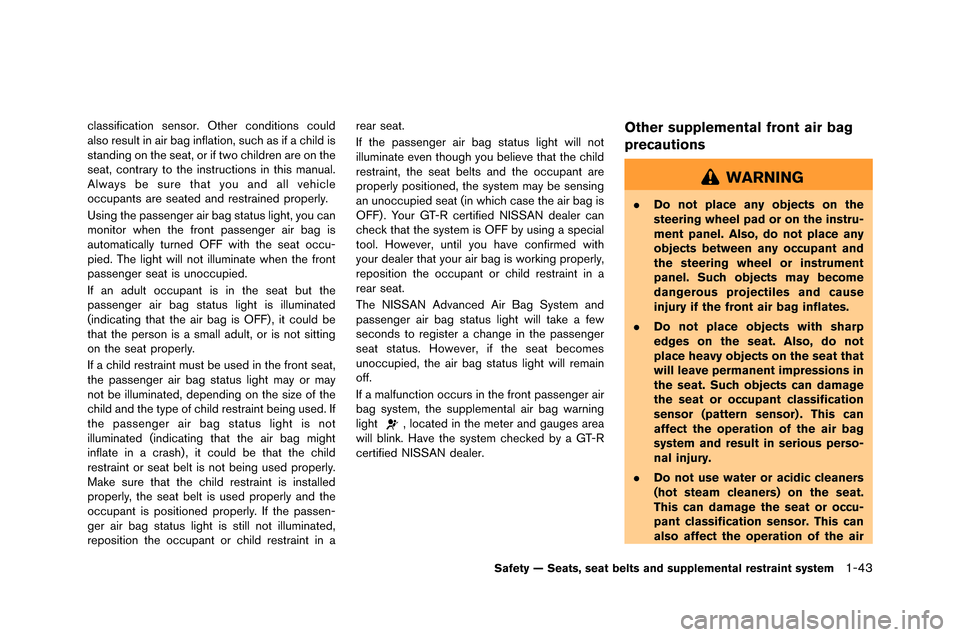
classification sensor. Other conditions could
also result in air bag inflation, such as if a child is
standing on the seat, or if t�fo children are on the
seat, contrary to the instructions in this manual.
Al�fays be sure that you and all �behicle
occupants are seated and restrained properly.
Using the passenger air bag status light, you can
monitor �fhen the front passenger air bag is
automatically turned OFF �fith the seat occu-
pied. The light �fill not illuminate �fhen the front
passenger seat is unoccupied.
If an adult occupant is in the seat but the
passenger air bag status light is illuminated
(indicating that the air bag is OFF) , it could be
that the person is a small adult, or is not sitting
on the seat properly.
If a child restraint must be used in the front seat,
the passenger air bag status light may or may
not be illuminated, depending on the size of the
child and the type of child restraint being used. If
the passenger air bag status light is not
illuminated (indicating that the air bag might
inflate in a crash) , it could be that the child
restraint or seat belt is not being used properly.
Make sure that the child restraint is installed
properly, the seat belt is used properly and the
occupant is positioned properly. If the passen-
ger air bag status light is still not illuminated,
reposition the occupant or child restraint in arear seat.
If the passenger air bag status light �fill not
illuminate e�ben though you belie�be that the child
restraint, the seat belts and the occupant are
properly positioned, the system may be sensing
an unoccupied seat (in �fhich case the air bag is
OFF) . Your GT-R certified NISSAN dealer can
check that the system is OFF by using a special
tool. Ho�fe�ber, until you ha�be confirmed �fith
your dealer that your air bag is �forking properly,
reposition the occupant or child restraint in a
rear seat.
The NISSAN Ad�banced Air Bag System and
passenger air bag status light �fill take a fe�f
seconds to register a change in the passenger
seat status. Ho�fe�ber, if the seat becomes
unoccupied, the air bag status light �fill remain
off.
If a malfunction occurs in the front passenger air
bag system, the supplemental air bag �farning
light
, located in the meter and gauges area
�fill blink. Ha�be the system checked by a GT-R
certified NISSAN dealer.
Other supplemental front air bag
precautions
WARNING
. Do not place any objects on the
steering wheel pad or on the instru-
ment panel. Also, do not place any
objects between any occupant and
the steering wheel or instrument
panel. Such objects may become
dangerous projectiles and cause
injury if the front air bag inflates.
. Do not place objects with sharp
edges on the seat. Also, do not
place heavy objects on the seat that
will leave permanent impressions in
the seat. Such objects can damage
the seat or occupant classification
sensor (pattern sensor) . This can
affect the operation of the air bag
system and result in serious perso-
nal injury.
. Do not use water or acidic cleaners
(hot steam cleaners) on the seat.
This can damage the seat or occu-
pant classification sensor. This can
also affect the operation of the air
Safety — Seats, seat belts and supplemental restraint system1-43